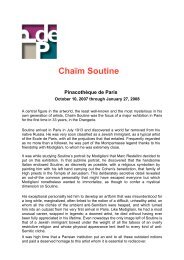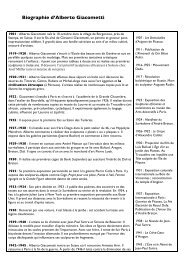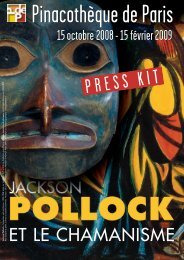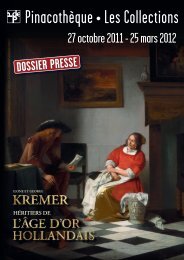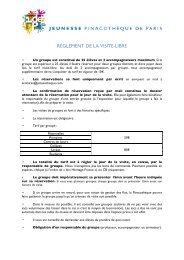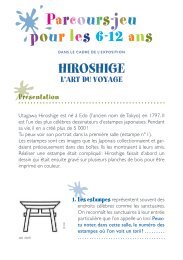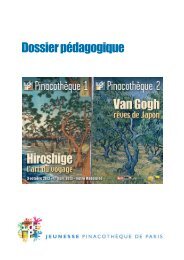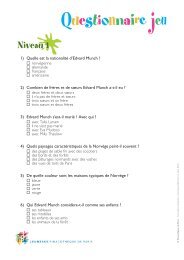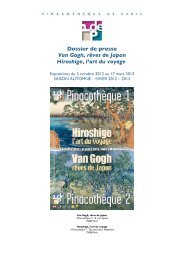Download - Pinacothèque de Paris
Download - Pinacothèque de Paris
Download - Pinacothèque de Paris
You also want an ePaper? Increase the reach of your titles
YUMPU automatically turns print PDFs into web optimized ePapers that Google loves.
assistant professor of art at Douglass College, the women’s college of Rutgers<br />
State University of New Jersey in New Brunswick, New Jersey, not far from New<br />
York City. At Rutgers, he meets Allan Kaprow who introduces him to Claes<br />
Ol<strong>de</strong>nburg, Lucas Samaras, George Segal, Robert Watts, Robert Whitman and<br />
others involved in the Happenings art scene. During his first year at Rutgers,<br />
Lichtenstein’s work is abstract. His paintings are created by dragging rags<br />
dipped in paint across the canvas to create ribbon-like bands. Sometime in the<br />
early summer of 1961, Lichtenstein paints “Look Mickey,” his first classic<br />
cartoon work to feature the half-tone effect of Benday dots created by dipping a<br />
dog-bristle brush in oil paint. Later that year, Lichtenstein begins to use a<br />
handma<strong>de</strong> metal screen and a paint roller to create the Benday dots effect on<br />
canvases that feature cartoons and consumer product imagery. In the fall of<br />
1961, Leo Castelli agrees to represent Lichtenstein’s works. Sales quickly follow.<br />
Following a trial separation from Isabel, Lichtenstein moves from his home in<br />
Highland Park, New Jersey, to Broad Street in New York, but they soon<br />
reconcile.<br />
In February of 1962, Leo Castelli showcases Lichtenstein’s works in a solo show<br />
featuring paintings based on serial comic strips and the rudimentary advertising<br />
images of newspaper copy. Over the course of that year, Lichtenstein’s Pop work<br />
is featured in six major exhibitions around the country. The following year he<br />
takes a leave of absence from Douglass, separates again from Isabel and moves<br />
his resi<strong>de</strong>nce and studio to West 26th Street where he begins a series of soap<br />
opera women and World War II combat motifs he finds in the pages of D.C.<br />
Comics serials. He enlarges his colored-pencil studies onto his canvas using an<br />
opaque projector and begins to use quick drying turpentine- soluble acrylic<br />
paint called Magna for large areas of the canvas but, because it dries too<br />
quickly, he continues to paint the Benday dots in oil now using store-bought<br />
metal perforated screens.<br />
In 1964, Lichtenstein returns to invented imagery with a series of horizon landscape<br />
paintings comprised primarily of Benday dots. Editioned enameled wall<br />
works of landscapes and comic-book imagery along with enameled standing<br />
explosions are inclu<strong>de</strong>d in his third show at Castelli in October of that year.<br />
Lichtenstein’s first mural is installed at the Flushing Meadows Fair Grounds for<br />
the 1964 World’s Fair.<br />
In 1965, separated from Isabel (they officially divorce in 1967) he moves to the<br />
3rd floor of a former German bank in New York’s Bowery. He begins a series of<br />
ceramic heads and stacked cups and saucers. At the same time, he is making<br />
15



